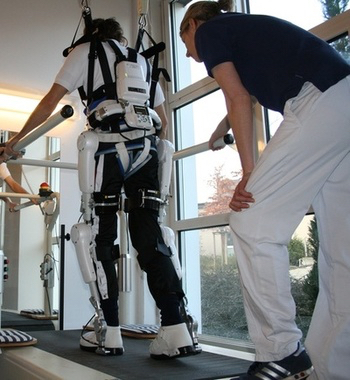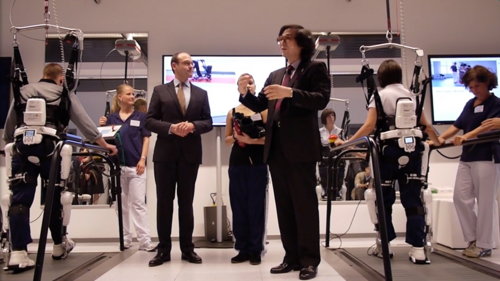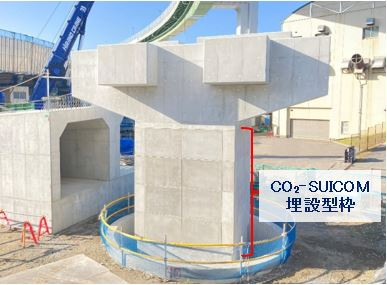J-STORIES ー 病気や障害などで失われたり、弱くなったりした身体機能を改善・回復させる世界初の装着型サイボーグ「HAL」を事業展開しているサイバーダイン(茨城県つくば市、山海嘉之代表取締役)が、革新的なベンチャー企業の技術を結集した新しい医療産業の創出に乗り出している。
同社のHAL(Hybrid Assistive Limb)は、人・ロボット・情報系を融合させたサイバニクス技術の一つで、人が身体を動かそうとする際に脳が発する信号を皮膚に貼り付けたセンサーで検出し、装着者の意思に従い身体を動かせるようアシストをする。医療の現場ではこの繰り返しにより身体機能の改善を促進する「サイバニクス治療」が実践されている。
筑波大学教授も務める同社代表の山海嘉之さんは、これからの医療にはHALのような最先端のロボット技術を中心に異分野を融合・複合した新しい産業、「サイバニクス」が必要だと話す。

そうした異分野の医療技術を結集する産業インフラの構築に向け、同社は2018年から先端ベンチャー企業に資金拠出し業務提携も行う「C-Startup」と名付けたプロジェクトを進めている。同社が中心となって国内外の医療機関、企業、大学、福祉施設などの関係づくりを推進。資金拠出のための「CEJファンド」は100億円規模をめざし、すでに大手金融機関や住宅関連メーカーなどが参加している。
C-Startupの目的は、グローバルな規模で「革新的な技術・機器の研究開発から社会実装までを一気通貫で推進すること」。同社はすでに再生医療、創薬、難病治療、ヘルスケア、アパレルなど様々な分野で提携を進めており、出資先のベンチャー企業は20社を超えた。
さらに、サイバーダインは異分野協業を推進する舞台として、昨年9月、神奈川県川崎市のキングスカイフロントに再生医療、バイオ、AI、ロボットなどの専門企業が知見を共有できる複合医療研究施設「サイバニクス医療イノベーションベース(A棟)」を開設した。現在、出資先企業の一つである心臓再生医療のメトセラ(神奈川県川崎市)などが入居している。
また、国外でも、マレーシアで昨年6月に、政府のプロジェクトとして東京ドーム約8個分の広さを持つ東南アジア最大の医療複合施設「国立神経ロボット・サイバニクスセンター」の建設が始まった。2024年の完成をめざしている。

テクノロジーの研究を行いつつ約17年に渡り細胞培養についても自身で研究する山海さんは、J-Storiesの取材に対し、科学技術というのは縦割りで分野が決まるものではなく、全領域が繋がっており、分野ごとの垣根を取り除くことが重要だという。
「科学技術の進歩の中で取り残されてきた人、高齢者や難病を抱えている弱い人たちをどこかの部屋に閉じ込めていく状況にしてはいけない」と指摘。「誰一人取り残さない、これからの巨大な地球村を作る上で、人とテクノロジーが仲間として相互に支援し合いながら社会を創っていく。これを実現させることが、私たちの役割になってくると思う」と話した。
昨年5月、日本内科学会が発行している英文のオンライン学術雑誌「Internal Medicine」にHALに関する論文を発表した東邦大学医学部脳神経内科グループの狩野修教授は、サイバニクス治療について「リハビリを行っても改善することのないALS(筋萎縮側索硬化症)という難しい病気に改善が見られる効果が証明できたことに価値がある」と指摘。
「サイバニクスは他の治療のような動物実験が難しい分野なので、病気の程度や個人差なども踏まえ、どのように使うことが効果的なのか解析を進めていくのが今後の課題だ」とJ-Storiesに話している。
記事:澤田由衣 編集:北松克朗
トップ写真:サイバーダイン 提供
この記事に関するお問い合わせは、jstories@pacificbridge.jp にお寄せください。
***
***
本記事の英語版はこちらからご覧になれます。
.jpg)




_bigthumbnail.jpeg)














![[PODCAST] 如何打造成功的新創企業社群(第2集)](https://storage.googleapis.com/jstories-cms.appspot.com/images/1748493203370business-man-holding-light-bulb-social-network-2024-10-31-22-37-36-utc_smallthumbnail.jpg)


